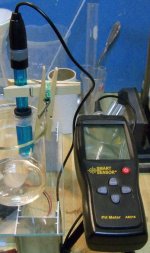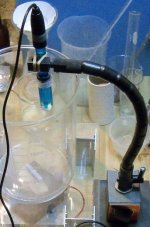merkin
Rising Star
Yeah, not so advanced at all! Didn't really know where to post this and have been searching for ages now without a win...so:
What do you recommend as a (non-expensive) way to measure pH in all these teks? I have one of those yellow/red ATC plastic 'pen' units (0.01) and it is extremely temperamental and sometimes takes forever to settle and often doesn't seem to read accurately. I have tried calibration but it often seems to defy settling. This is my second one (just couldn't calibrate the last one and it never agreed with the pH strips) and I just don't trust the thing but pH strips just don't get accurate enough to distinguish a reading of 8.75.
Also, do you dip it in and leave it in while you add base or acid? or do you remove and clean and then add and then dip the reader in after every change? I have been trying to separate some rue harmalas per phlux's telepathine method but finding it impossible to be so subtle as to hit the desired pH.
As someone with zero chemistry background after high school (oh so very long ago), I am pretty ignorant of basic methods and common tools. Googling and eBay just seem to bring up these same devices. Any pointers would be appreciated. Thanks
What do you recommend as a (non-expensive) way to measure pH in all these teks? I have one of those yellow/red ATC plastic 'pen' units (0.01) and it is extremely temperamental and sometimes takes forever to settle and often doesn't seem to read accurately. I have tried calibration but it often seems to defy settling. This is my second one (just couldn't calibrate the last one and it never agreed with the pH strips) and I just don't trust the thing but pH strips just don't get accurate enough to distinguish a reading of 8.75.
Also, do you dip it in and leave it in while you add base or acid? or do you remove and clean and then add and then dip the reader in after every change? I have been trying to separate some rue harmalas per phlux's telepathine method but finding it impossible to be so subtle as to hit the desired pH.
As someone with zero chemistry background after high school (oh so very long ago), I am pretty ignorant of basic methods and common tools. Googling and eBay just seem to bring up these same devices. Any pointers would be appreciated. Thanks



